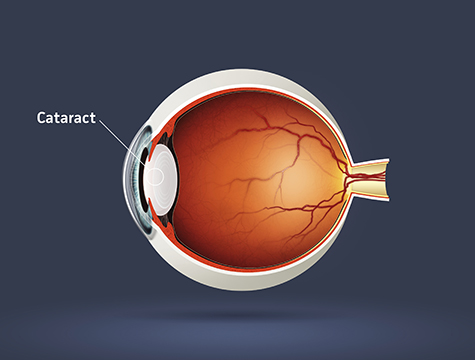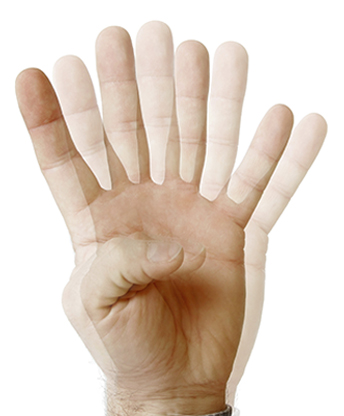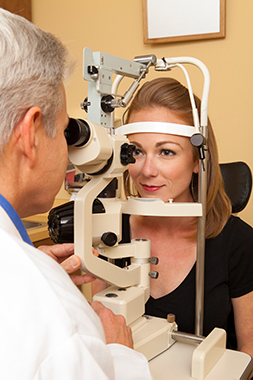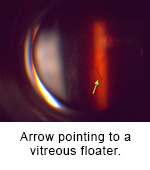Welcome to the Eye Care Associates newsletter
We thank you for being a patient and hope you will enjoy this information about our practice and your overall eye health.
The ABCD’s of Cataracts

Affecting your eyesight
In a normal eye, light enters and passes through the lens. The lens focuses the light into a sharp image on the retina, which relays messages through the optic nerve to the brain. If the lens is cloudy from a cataract, the image you see will be blurry. Other eye conditions, such as myopia, may also cause blurry vision, but cataracts produce some distinctive signs and symptoms.
A cataract is a progressive, painless clouding of the natural, internal lens of the eye. Cataracts block light, making it difficult to see clearly. Over an extended period of time, cataracts can cause blindness.
The majority of cataracts are related to aging. More than half of Americans over 65 have cataracts, but they can develop in younger people too. Babies can be born with what are known as congenital cataracts, and children may develop them as a result of injury or illness.
Blurry vision
Blurry vision at any distance is the most common symptom of cataracts. Your view may look foggy, filmy, or cloudy. Over time, as cataracts worsen, less light reaches the retina. People with cataracts may have an especially hard time seeing and driving at night.
 Color changes Color changes
Cataracts can affect your color vision, making some hues look faded. Your vision may gradually take on a brownish or yellowish tinge. You may not notice this discoloration at first, but over time it may become more difficult to distinguish blues and purples.
Other early symptoms of cataracts are glare and sensitivity to light. You may have trouble seeing in bright sunlight. Indoor lights that once didn’t bother you now may seem too bright or have halos. Driving at night may become a problem because of the glare caused by street lights and oncoming headlights.
 Double Vision Double Vision
Sometimes, cataracts can cause double vision (diplopia). Images will appear double in the eye affected by cataract even with only one eye open. This differs from double vision caused by the eyes not working with each other properly due to a muscle issue. In this case, the double vison usually goes away when either one of the eyes is shut.
CLICK HERE TO READ MORE ABOUT EYE CATARACTS
Eye Fatigue
Eye fatigue or eye strain is a common and often irritating condition. Symptoms include tired, itching, and burning eyes. It is rarely a serious condition and common sense precautions at home, work, and outdoors may help to prevent or reduce it.
 Sometimes eye fatigue is a sign of an underlying condition that may need medical treatment. If eye fatigue persists despite taking simple precautions, see your doctor. This is especially important if your eye fatigue is associated with headaches or with eye problems such as: Sometimes eye fatigue is a sign of an underlying condition that may need medical treatment. If eye fatigue persists despite taking simple precautions, see your doctor. This is especially important if your eye fatigue is associated with headaches or with eye problems such as:
- Discomfort
- Double vision
- Significant change in vision
Symptoms of Eye Fatigue
Eye fatigue is associated with uncomfortable and bothersome symptoms, such as:
- Sore or irritated eyes
- Difficulty focusing
- Dry or watery eyes
- Blurred or double vision
- Increased sensitivity to light
- Pain in the neck, shoulders, or back
These symptoms can decrease your productivity. They may be intensified by sleep deprivation. During sleep, the eyes are replenished with essential nutrients. Lack of sleep may result in persistent eye irritation.
CLICK HERE TO READ MORE ABOUT EYE FATIGUE; CAUSES AND WAYS TO PREVENT
Vitreous Floaters
Vitreous floaters are small moving spots that appear in your field of vision. They may be especially noticeable when you look at something bright, such as white paper or a blue sky. While annoying, floaters don't interfere with your sight in most cases.
 Occasionally a particularly large floater may cast a subtle shadow over your vision. This tends to occur only in certain types of light. Most of the time people learn to live with floaters and ignore them as they often improve over months to years. Only rarely do benign floaters become bothersome enough to consider treatment. Occasionally a particularly large floater may cast a subtle shadow over your vision. This tends to occur only in certain types of light. Most of the time people learn to live with floaters and ignore them as they often improve over months to years. Only rarely do benign floaters become bothersome enough to consider treatment.
Sometimes floaters are a sign of a more serious condition. You should seek immediate medical attention if you notice a sudden increase in the number of floaters.
Immediate medical attention is especially important if the floaters are accompanied by brief flashes of light or a loss of side vision. If you have these symptoms, see your ophthalmologist right away. These symptoms may be caused by:
 Retinal detachment Retinal detachment
- Retinal tear
- Bleeding within the eye
Retinal detachments, tears and holes require immediate treatment to prevent permanent loss of vision.
CLICK HERE TO READ ABOUT THE SYMPTOMS, CAUSES AND TREATMENT OF FLOATERS
|




